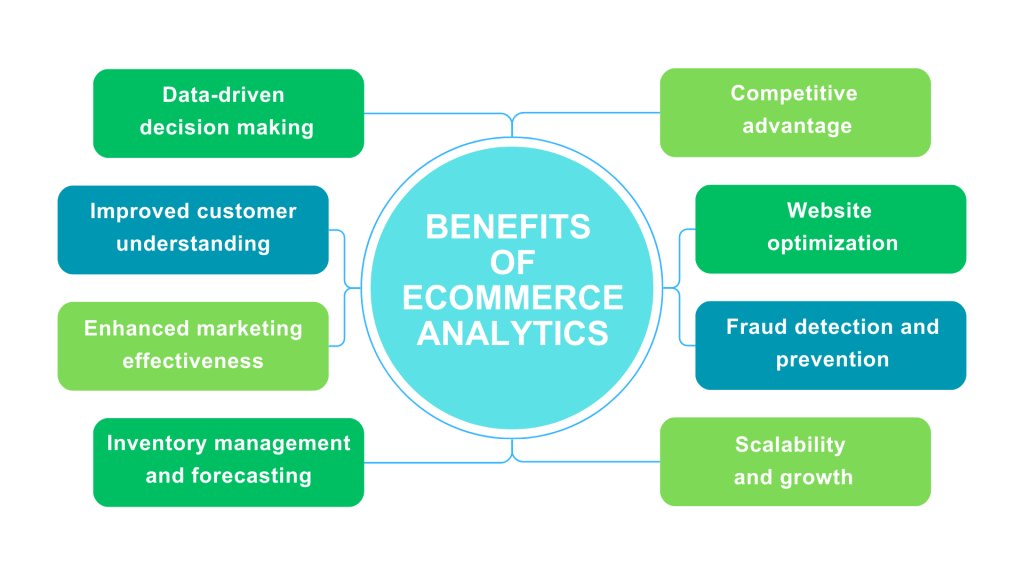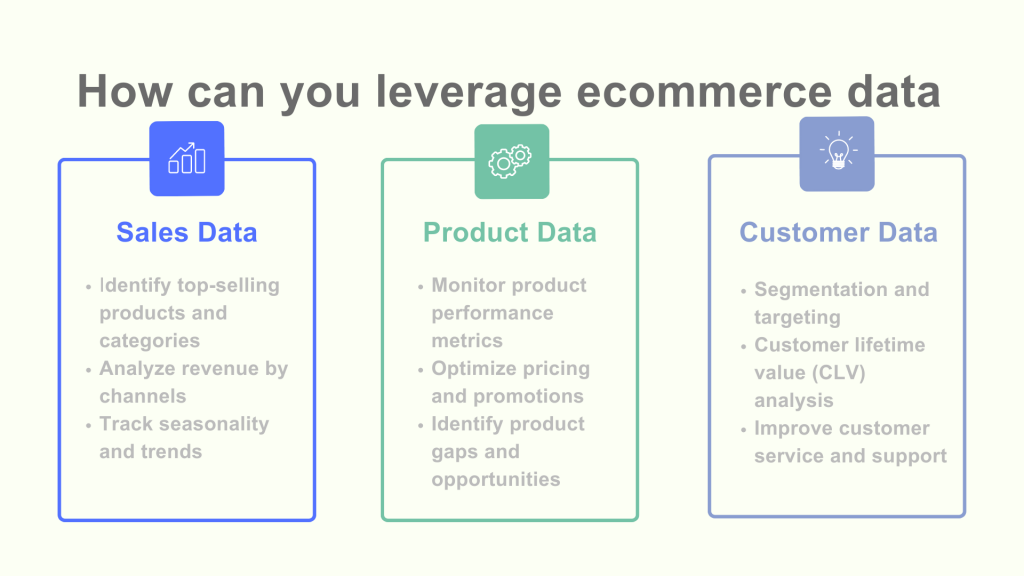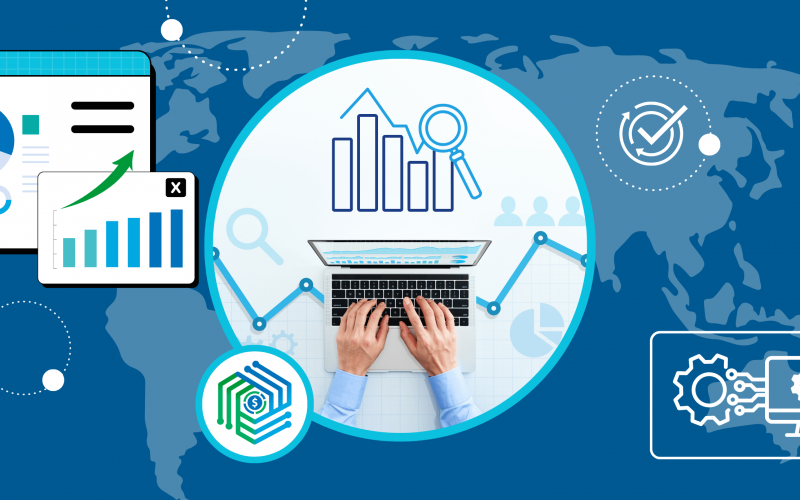In today’s data-driven world, businesses must harness the power of analytics to gain a competitive edge. The ecommerce industry is no exception, as effective data collection and analysis can significantly impact a business’s success. To thrive in the ecommerce landscape, it’s crucial for businesses to leverage top-notch ecommerce analytics tools. These tools empower businesses to make informed decisions based on valuable business insights derived from comprehensive data analysis.
Navigating the vast array of available ecommerce analytics tools can be overwhelming. To streamline your decision-making process, we’ve compiled a list of the five essential ecommerce business analytics tools. These tools encompass a wide range of functionalities, ensuring that businesses can optimize their data-driven strategies across multiple dimensions.
Hop on reading to learn more about ecommerce analytics and analytics tools:
1. What is ecommerce analytics?
2. What are the benefits of ecommerce analytics for a business?
3. What data does ecommerce analytics explore?
4. Why do ecommerce businesses need analytics tools?
5. How does ecommerce analytics software help businesses fetch data from all their ecommerce platforms?
6. Ecommerce analytics tools you might want to consider
What is ecommerce analytics?
Before we get to ecommerce analytics tools, let’s define ecommerce analytics, and why it’s important for businesses.
Ecommerce analytics refers to the practice of collecting, analyzing, and interpreting data from sales channels to gain valuable insights into customer behavior, sales trends, and overall business performance. It involves the use of various tools, techniques, and metrics to make informed decisions and drive strategic improvements in the online business environment.
As online businesses continue to grow, the need for data-driven insights to optimize performance and drive growth has become of dramatic demand. This is where ecommerce analytics comes into play.
The primary objective of ecommerce analytics is to unlock actionable insights that can be leveraged to enhance the customer experience, increase conversions, boost sales, and improve overall business performance. Online sales channels generate volumes of data, and ecommerce analytics enables businesses to leverage it to understand customer preferences, identify emerging market trends, and optimize various aspects of their digital operations.
Key components of ecommerce analytics
As mentioned above, ecommerce analytics encompasses a wide range of activities and methodologies, including collecting and analyzing data and presenting it in a form of metrics and KPIs a business can track to understand their performance.
Data collection
The first step in ecommerce analytics is the collection of relevant data from various sources such as website traffic, customer transactions, social media interactions, and marketing campaigns. This data can be obtained through tools like web analytics platforms, customer relationship management software, and marketing automation software.
Data analysis
Once the data is collected, it needs to be analyzed to extract meaningful insights. Data analysis techniques such as segmentation, cohort analysis, A/B testing, and more are used to identify patterns, trends, and correlations within the data. Advanced analytics methods like predictive modeling and machine learning can also be applied to gain deeper insights and make accurate predictions.
Metrics and KPIs
Ecommerce analytics relies on the use of key performance indicators (KPIs) and metrics to measure the success of online retail operations. Common metrics include conversion rate, average order value, customer lifetime value, cart abandonment rate, and customer acquisition cost. These metrics help businesses track their progress, identify areas for improvement, and set goals for growth.
What are the benefits of ecommerce analytics for a business?
Ecommerce analytics offers numerous benefits for businesses operating in the digital marketplace. From data-driven decision-making and customer understanding to marketing effectiveness and fraud prevention, leveraging ecommerce analytics can significantly enhance business performance, improve customer experiences, and drive sustainable growth in the competitive ecommerce landscape.

Data-driven decision making
Ecommerce analytics allows businesses to make informed decisions based on real-time data. By analyzing customer behavior, purchase patterns, and product performance, businesses can gain valuable insights into what works and what doesn’t. This data-driven approach helps identify opportunities for improvement, optimize marketing strategies, and make more accurate forecasts for inventory management and sales projections.
Improved customer understanding
Ecommerce analytics provides businesses with a deep understanding of their customers. By analyzing customer demographics, preferences, and browsing behavior, businesses can segment their customer base and tailor marketing efforts to specific target groups. This level of personalization can lead to improved customer experiences, higher conversion rates, and increased customer loyalty.
Enhanced marketing effectiveness
Ecommerce analytics empowers businesses to measure the effectiveness of their marketing campaigns accurately. By tracking key metrics such as click-through rates, conversion rates, and customer acquisition costs, businesses can identify which marketing channels and strategies yield the best results. This knowledge enables businesses to allocate their marketing budget more efficiently, optimize their campaigns, and achieve higher return on investment (ROI).
Inventory management and forecasting
Accurate inventory management is crucial for ecommerce businesses. By analyzing historical sales data, businesses can predict demand patterns, identify seasonal trends, and optimize inventory levels. Ecommerce analytics enables businesses to avoid stockouts and overstock situations, leading to improved cash flow and reduced storage costs.
Competitive advantage
Ecommerce analytics provides businesses with a competitive edge in the market. By leveraging data insights, businesses can identify emerging trends, monitor competitor performance, and stay ahead of the competition. This information allows businesses to adapt quickly, identify untapped market opportunities, and make strategic decisions that can position them as industry leaders.
Website optimization
Ecommerce analytics plays a vital role in optimizing website performance. By tracking user behavior, businesses can identify areas of their website that need improvement, such as page load times, navigation flow, and checkout processes. With this knowledge, businesses can enhance the overall user experience, reduce bounce rates, and increase conversion rates.
Fraud detection and prevention
Ecommerce analytics helps businesses identify and mitigate fraudulent activities. By monitoring transactional data and applying advanced analytics techniques, businesses can detect suspicious patterns and anomalies indicative of fraudulent behavior. This proactive approach minimizes financial losses, protects customer data, and enhances overall security.
Scalability and growth
Ecommerce analytics enables businesses to scale their operations effectively. By analyzing performance metrics and identifying growth opportunities, businesses can make data-driven decisions regarding expanding product offerings, entering new markets, or optimizing their supply chain. This strategic approach helps businesses navigate growth challenges and maximize their potential for success.
What data does ecommerce analytics explore?
Ecommerce analytics looks into different types of data, including sales, product, and customer data, that has the biggest impact on business performance. Based on the findings of the data analysis, ecommerce companies can drive strategic decisions and improve their performance where it’s necessary. So basically, ecommerce analytics helps decipher the meaning behind those numbers on sales, fulfilled orders, customers, and products. And the data can speak volumes of your business. Let’s look at what ecommerce data can tell you, and how you can leverage it.

What can sales data tell you?
Sales data provides a comprehensive picture of a company’s revenue streams, allowing businesses to evaluate their financial performance and identify trends and patterns. By analyzing sales data, ecommerce companies can:
- Identify top-selling products and categories. Sales data helps identify the most popular products or categories, allowing businesses to focus on high-demand items and allocate resources accordingly. For example, an online clothing retailer can identify that dresses are the best-selling category and invest in expanding that product line.
- Analyze revenue by channels. Sales data can reveal the performance of different sales channels, such as a website, mobile app, or marketplace platforms. This information helps companies understand which channels are generating the most revenue and optimize their marketing and sales strategies accordingly.
- Track seasonality and trends. Sales data provides insights into seasonal fluctuations and trends, enabling businesses to plan marketing campaigns and inventory management accordingly. For instance, an ecommerce business specializing in outdoor gear may notice increased sales during the summer season and prepare targeted promotions and stock replenishment.
What can product data tell you?
Product data refers to the information related to individual products available for sale on an ecommerce platform. Analyzing product data offers valuable insights into product performance, customer preferences, and inventory management. Here’s how ecommerce companies can leverage product data:
- Monitor product performance metrics. Product data can provide detailed information on key performance metrics such as conversion rates, average order value, and customer reviews. By analyzing these metrics, businesses can identify which products are performing well and which ones require improvement or optimization.
- Optimize pricing and promotions. Product data allows businesses to track the impact of pricing strategies and promotional campaigns on sales. For instance, by analyzing product data, an ecommerce company may discover that offering a limited-time discount on a specific product leads to a significant increase in sales volume.
- Identify product gaps and opportunities. By analyzing product data, businesses can identify gaps in their product offerings and uncover opportunities for expansion. For example, an online electronics retailer may notice a high demand for a particular type of smartphone and decide to source and offer that product to capture additional market share.
What can customer data tell you?
Customer data provides insights into the behavior, preferences, and demographics of online shoppers. Analyzing customer data is crucial for personalization, improving customer experience, and driving customer loyalty. Here’s how ecommerce companies can leverage customer data:
- Segmentation and targeting. Customer data enables businesses to segment their customer base based on various factors like demographics, purchase history, and browsing behavior. This segmentation allows for targeted marketing campaigns and personalized product recommendations, increasing the chances of conversion and customer retention.
- Customer lifetime value (CLV) analysis. Customer data helps determine the CLV, which is the predicted revenue a customer will generate throughout their relationship with a business. By analyzing CLV, ecommerce companies can identify their most valuable customers and develop strategies to maximize their retention and lifetime value.
- Improve customer service and support. Customer data provides insights into customer preferences, feedback, and support interactions. By analyzing this data, businesses can identify areas for improvement in their customer service processes, enhance response times, and address customer pain points promptly.
Why do ecommerce businesses need analytics tools?
If ecommerce analytics is an absolute must for businesses to make sense of their performance numbers, ecommerce analytics tools are necessary to help perform the task of gathering, analyzing, and presenting data the way it can be useful. Here’re top reasons why you can’t go without analytics tools if you want to analyze your business data properly.
Data volumes
One of the key reasons why analytics tools are crucial for ecommerce businesses is the sheer volume and complexity of data involved. Ecommerce websites generate a plethora of data points, including customer demographics, browsing patterns, purchase history, cart abandonment rates, you name it. Attempting to manually gather and analyze this data would be a monumental task, prone to errors and inefficiencies. Analytics tools automate the data collection process, ensuring accurate and comprehensive data sets.
Pinpointing interdependencies and correlations within data
Analytics tools offer sophisticated analysis capabilities that go beyond what can be achieved manually. These tools use advanced algorithms and machine learning techniques to identify patterns, trends, and correlations within the data. By uncovering these insights, businesses can make data-driven decisions that enhance customer experience, optimize marketing campaigns, and improve overall operational efficiency.
Real-time data overview
Analytics tools provide real-time and actionable data. Ecommerce businesses can monitor website performance, user behavior, and sales metrics in real time, allowing for immediate responses and adjustments. By quickly identifying and addressing issues such as high bounce rates or slow page load times, businesses can enhance user experience and prevent potential revenue loss.
How does ecommerce analytics software help businesses fetch data from all their ecommerce platforms?
Unless you’re a super niche ecommerce business, selling exclusive hand-knitted Peruvian llama wool wedding dresses (or whatever as rare and peculiar as they are), you might be selling through several ecommerce platforms and, probably, marketplaces, Instagram, a standalone online store, you name it. In other words, your sales are multi-channel. So at this point, you, as many other businesses, are increasingly relying on ecommerce analytics software to gather, integrate, and analyze data from various sources. Here’s how they actually do it, enabling you to harness that power your business data provides.
Centralized data collection
Ecommerce analytics software acts as a centralized hub, allowing businesses to collect data from multiple ecommerce platforms, such as Shopify, WooCommerce, Magento, and more. By connecting to these platforms, the software gathers essential data points, including sales transactions, customer behavior, product performance, inventory levels, and marketing campaign data. This holistic approach to data collection eliminates the need for manual data gathering from different sources, saving time and effort for businesses.
Real-time data sync
One of the key advantages of ecommerce analytics software is its ability to sync data in real time. As businesses receive new orders, customer information, or inventory updates, the software automatically fetches and updates the data, ensuring that insights and reports are based on the most recent information. Real-time data sync empowers businesses to make agile decisions and respond quickly to market trends and customer demands.
Integration with business tools
Ecommerce analytics software goes beyond simply gathering data from ecommerce platforms; it also integrates seamlessly with various AI business tools to provide a comprehensive view of operations. These tools may include customer relationship management (CRM) systems, email marketing platforms, inventory management systems, and marketing automation software. By integrating with these tools, the software enables businesses to correlate ecommerce data with customer interactions, marketing campaigns, and inventory levels, uncovering meaningful insights and driving personalized strategies.
Data visualization and reporting
Effective data analysis hinges on the ability to transform raw data into meaningful data visualizations and reports. Ecommerce analytics software offers robust reporting features, providing businesses with interactive dashboards, charts, and graphs to visualize key performance indicators (KPIs) and metrics. These intuitive visual representations make it easier for stakeholders to understand trends, identify opportunities, and track progress towards goals. Additionally, customizable reports enable businesses to generate specific insights tailored to their unique needs.
Advanced analytics and predictive insights
Ecommerce analytics software goes beyond basic data reporting by offering advanced analytics and predictive capabilities. By leveraging machine learning algorithms and statistical models, businesses can uncover hidden patterns, segment customers, and predict future trends. These predictive insights enable businesses to optimize pricing strategies, identify cross-selling and upselling opportunities, personalize customer experiences, and enhance overall operational efficiency.
Ecommerce analytics tools you might want to consider
So far, so good, we’re getting now to the best part, which is the selection of tools that might help you make ecommerce analytics a breeze, enabling you to track your business performance, understand the correlation between your activities, marketing campaigns, store optimizations, customer retention efforts, and more and the increase or decrease in sales. Definitely, they might not be a 100% ideal for everyone – all businesses have their peculiarities, and it’s impossible to cater for everyone’s requirements – but you can explore them to understand, based on your goals and needs, which might become a perfect solution for you.
1. Synder – multi-channel ecommerce analytics
Synder is a business insights platform that connects to all your sales and payments platforms, allowing you to track your business performance in one place. It acts as a single source of truth for all your financial metrics, facilitating data-driven decisions.
Because the tool connects with all major ecommerce platforms like eBay, Shopify, PayPal, and Amazon (25+ payment, ecommerce, and accounting systems altogether), it can be used to sync all transactions into one real-time ecosystem. It can also be used to generate financial reports for your business, helping you track your progress and identify areas of improvement. We talk more about business reports in our recent post on how to document data in business reports.
If you’ve left your business finances to the mercy of Google Sheets, make sure to check out Synder.
Find out more about Synder and how it can help you make sense of your ecommerce numbers: book a seat at our webinar to have all your questions answered or sign up for a free trial and explore Synder’s capabilities yourself.
2. Hotjar – user behavior analytics tool
Hotjar is a behavior analytics tool that allows you to see how your website visitors are interacting with your site. It provides heatmaps and recordings of visitor sessions so you can see what they’re doing and where they’re struggling.
This is valuable information that can be used to improve your website’s design and user experience–it can also be used to identify areas of your website that are confusing or difficult to use. Hotjar offers a survey tool that you can use to gather feedback from your website visitors, which is an invaluable way to get insights into what your visitors think about your site and what you can do to improve it.
3. Google Analytics – comprehensive web analytics
Google Analytics is a free web analytics tool that provides insights into your website traffic and marketing effectiveness. It can be used to track visitors’ behavior, identify areas of your website that need improvement, and measure the effectiveness of marketing campaigns.
One of the most useful features of Google Analytics is the ability to track conversions. This information can be used to determine which marketing campaigns are driving sales and leads. Using data-driven attribution is also a powerful tool, as this data is utilized to assign credit to the various marketing channels that contribute to a sale or lead. This way you can optimize your marketing spending and get the most out of your campaigns. However, one downside to this tool is its complexity – it can be difficult to understand and use, especially for beginners, and you’ll need to spend a bit of time learning to fully utilize its features.
4. Right Inbox – email marketing analytics
Email marketing is a major driver of success for ecommerce businesses. In order to get the most out of your email marketing campaigns, you need to be using the right tools. Right Inbox is an email productivity tool that helps you get the most out of your email marketing campaigns, allowing you to schedule your emails and track email opens and clicks so you can see what’s working and what’s not.
Finally, it allows you to create email templates so you can save time when creating your emails. This tool is essential for any ecommerce business that wants to get the most out of their email marketing.
5. Optimizely – performance analytics
Last but not the least, Optimizely is a tool that allows you to test different versions of your website to see which performs better–this valuable information can be used to improve your website’s conversion rate. It’s important to note that you’ll need a significant amount of website traffic to get reliable results from this tool, so if you don’t have a lot of traffic, you may want to consider a different option.
For more information on how business analytics can help you grow, check out our post on using analytics in ecommerce.
Bottom line
As you can see, ecommerce analytics tools are essential for businesses to thrive in the data-driven world of ecommerce. These tools enable businesses to collect, analyze, and interpret data to gain valuable insights into customer behavior, sales trends, and overall business performance. By leveraging top-notch analytics tools, businesses can make informed decisions based on comprehensive data analysis, leading to improved customer understanding, enhanced marketing effectiveness, optimized inventory management, and a competitive advantage in the market. Ecommerce analytics tools streamline the data collection process, provide real-time data sync, integrate with other business tools, offer data visualization and reporting features, and even provide advanced analytics and predictive insights.

.png)




